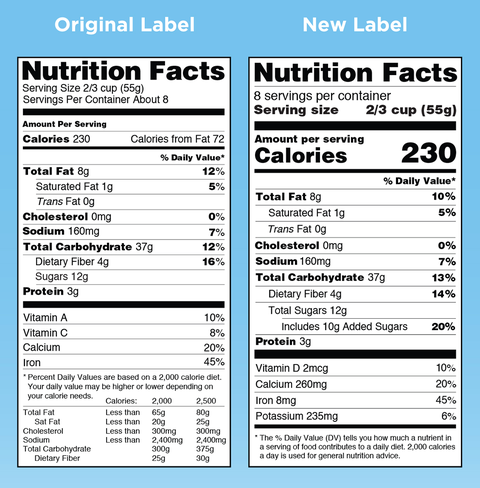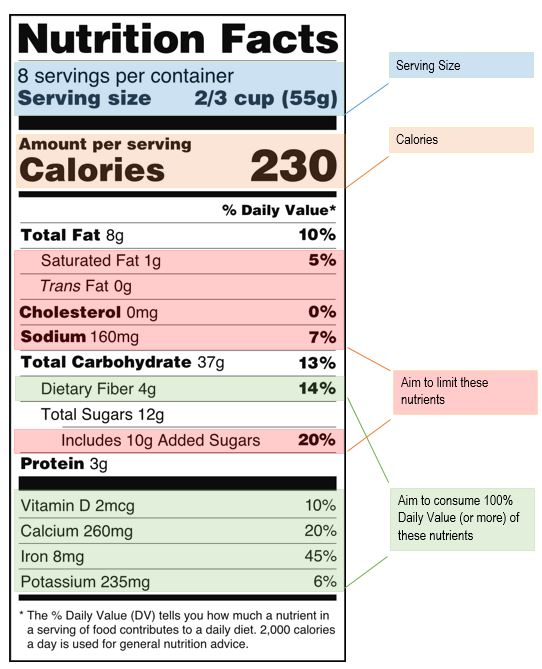The amount of calories a person needs each day depends on a lot of factors including
- Sex
- Age
- Physical activity level
- Nutritional needs
- Whether the person aims to lose, maintain, or gain weight
Ask your doctor or a registered dietitian for a daily calorie goal based on your needs.
Calories are not the only important information on the Nutrition Facts label. Many people consume more calories than they need without meeting the recommended amounts of important nutrients. A food that is low in calories but also low in nutrients may still not be a good food choice. A food that is high in calories may still be a good food choice if it is also high in the nutrients your body needs.
Nutrients and % Daily Value
Based on a 2,000 calorie-per-day diet, the % Daily Value tells you the percentage of the recommended daily intake for each nutrient. For example, a food with 5% of the Daily Value of fiber provides 5% of the total fiber that a person consuming 2,000 calories a day should eat each day.
Your calorie needs may be more or less than 2,000 calories per day. The amount you need of a specific nutrient may be more or less than the recommended Daily Value. Ask your doctor or a registered dietitian for guidance.
Even if your nutritional needs are different, you can still use the % Daily Value to determine if a serving of a food is high or low in a nutrient.
A low % Daily Value is 5 percent or less. Choose foods that are low in saturated fat, Trans fat, cholesterol, added sugar and sodium. Aim to eat less than 100% of the Daily Value for these nutrients each day.
A high % Daily Value is 20 percent or more. Choose foods that are high in dietary fiber, vitamin D, calcium, iron, and potassium. Aim to eat 100% Daily Value or more of these nutrients each day.
Read Boosting Your Immune System to learn more about key nutrients.
Nutrients without % Daily Value
Trans fat and total sugars do not list a % Daily Value on the label because there are no recommendations for the amount to eat per day.
Aim to keep your intake of trans fat as low as possible. Trans fat is linked to increased risk of heart disease. Examples of foods that may contain trans fat includes baked goods, chips, fried foods, creamer, and margarine.
Aim to keep your daily intake of added sugar below 25 grams for women and below 37 grams for men. Added sugars are sugars added during preparation or processing, or are packaged as such (e.g. table sugar). Examples of foods that contain added sugar include sugars from syrups and honey, sugar sweetened beverages, candy, cookies, pies, dairy desserts, milk products, and sugar sweetened cereals.
For protein, a % Daily Value is only required to be listed if the food claims to be high in protein. How much protein do you need each day? Divide your ideal weight by 2 to determine the minimum grams of protein your body needs daily. Cancer patients may need to increase their protein intake. Ask your doctor or a registered dietitian for a recommendation.
Learn more about the Nutrition Facts label
U.S. Food and Drug Administration (FDA): Changes to the Nutrition Facts Label
Academy of Nutrition and Dietetics: The Basics of the Nutrition Facts Label


